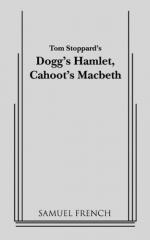|
This section contains 1,425 words (approx. 4 pages at 400 words per page) |

|
Communication
Communication is the central theme of Dogg's Hamlet, and it provides a means for connecting this play to Cahoot's Macbeth. When the play begins, the schoolboys speak, using English words such as "Brick!" and "Cube," but they use them in ways that are unconventional for the presumably English speaking audience. For example, when Abel tests the microphone, he says, "Breakfast, breakfast . . . sun—dock—trog . . . ," a phrase that, in English, means "Testing, testing . . . one—two—three. . ." For Stoppard's readers, he includes translations in brackets, converting these Dogg words into English. Stoppard's audience, however, does not receive these translations and so must pick up the meaning in context.
This is also true for the character Easy, who becomes a representative for the audience. When Easy first arrives at the school to deliver building supplies and to help construct a platform for the stage, he only knows...
|
This section contains 1,425 words (approx. 4 pages at 400 words per page) |

|




